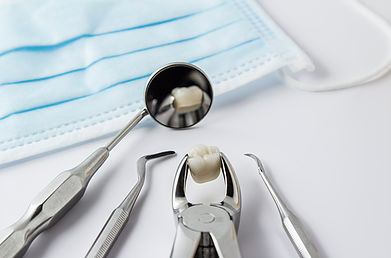A dental extraction (also referred to as tooth extraction, exodontia) is the removal of a tooth or teeth from the dental alveolus (socket) in the alveolar bone.
Reasons For Pulling A Tooth
Although permanent teeth were meant to last a lifetime, there are a number of reasons why a tooth extraction may be needed. A very common reason involves a tooth that is too badly damaged, from trauma or caries and cannot be repaired. Other reasons include:

- Severe gum disease (periodontal disease). This is caused by bacteria building up on your teeth and damaging the bone that holds them in place. The teeth become loose and will need to be removed professionally.
- Crowded teeth. If you have a small jaw or lost your milk (baby) teeth early, your teeth may be crooked and you may need to have one or more removed so the rest can be straightened
- Prior to radiation therapy in the jaw.
Preparing For A Tooth Extraction
Your oral surgeon will ask you about your dental and medical history. It’s important that you tell them about any medical conditions, allergies or recent operations. You should also tell your oral surgeon if you use an inhaler or are taking any medicines, including the contraceptive pill, over-the-counter medicines and herbal medicines such as fish oil as a lot of them cause bleeding in surgery.
If you’re particularly anxious about having treatment, you may need to go to hospital and have the tooth removed under general anaesthetic, which means you will be asleep and feel no pain while your tooth is being removed.
What Happens During A Tooth Extraction
So that you don’t feel any pain during or immediately after the procedure, your oral surgeon will give an injection of local anaesthetic into your mouth. This completely blocks feeling from the area so you don’t feel any pain during the procedure, though you may feel some pressure in your mouth and hear some noise.
After the anaesthetic has taken effect, your oral surgeon will widen the socket (the area your tooth sits in) using a tool called an elevator or a pair of special forceps. They will then move the tooth from side to side until it’s loose enough to be removed completely.
In more difficult and rarer cases, your oral surgeon may not be able to reach the root of your tooth so small cuts will be made in your gum followed by some conservative bone drilling to allow for root removal.
What To Expect Afterwards
There will be some bleeding and your oral surgeon may put in stitches. After the extraction, you will be given a piece of soft gauze padding to bite on to stop the bleeding.
If you’ve had your tooth removed under local anaesthesia, you’ll need to stay at the surgery until the bleeding is controlled. This will probably take about 10 minutes. You may need pain relief to help with any discomfort as the anaesthetic wears off.
If you’ve had general anaesthesia or sedation, you’ll need to arrange for someone to drive you home. You will need to have someone, a friend or relative stay with you until the next day. Both sedation and general anaesthesia temporarily affect your co-ordination and reasoning skills, so you must not drive, drink alcohol, operate machinery or sign legal documents until your oral surgeon/anaesthetist tells you it’s safe to do so. This will be at least until the next day.
Wait until the local anaesthetic has worn off before having hot food or drinks – you might burn your mouth or chew the inside of your cheek while it’s still numb. Once you regain some feeling, stick to lukewarm, soft food and try not to chew in the part of your mouth where the tooth has been removed. Try not to drink alcohol or smoke for the first 24 hours after the extraction – this may cause further bleeding and enhance a dry socket.
It’s best not to rinse out your mouth for the first 24 hours after the extraction. This is because any blood clot that may have formed could be disturbed and the bleeding could start again. After the first 24 hours, you should start rinse out your mouth with warm salt water (half a teaspoon of salt in a glass of warm water) at least 3 times a day.
Recovering From A Tooth Extraction
It’s important to keep your mouth as clean as possible so continue brushing your teeth as normal after the extraction but keep your toothbrush away from the healing wound for the first couple of days.
Continue mouth rinsing with warm salt water, at least 3 times a day until your follow up appointment with your oral surgeon.
If you had stitches during the procedure, these are dissolvable however your oral surgeon may remove these at your follow up appointment which normally occurs 10 – 14 days after surgery.
